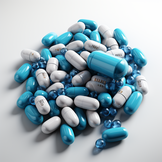Exercises to treat erectile dysfunction.
- Understanding Erectile Dysfunction (ED)
- Pelvic Floor Exercises (Kegels) and their Benefits
- The Role of the Pubococcygeus Muscle in ED
- Aerobic Exercises for Improving ED
- Medications for ED: Sildenafil (Viagra)
- Diet and Lifestyle Modifications for ED Treatment
- Pilates and Weight Training as Additional Exercise Options
- Importance of Consulting a Healthcare Provider before Starting an Exercise Program

Understanding Erectile Dysfunction (ED)
Erectile dysfunction, commonly referred to as ED, is a medical condition where a man is unable to maintain an erection sufficient for satisfactory sexual intercourse. This disorder can cause significant distress and impact a person's quality of life. However, with appropriate intervention and a multi-modal approach that includes exercise, medication, and lifestyle modifications, the symptoms can be managed effectively.
Pelvic Floor Exercises (Kegels) and their Benefits
Among the various exercises to treat erectile dysfunction, pelvic floor exercises, also known as Kegels, play a crucial role. These exercises mainly target the pubococcygeus muscle, a vital muscle in sexual health, which helps support the pelvic organs and control the flow of urine. Strengthening this muscle can improve sexual performance and alleviate the symptoms of ED. To perform these exercises, one must contract, hold, and then relax the pelvic muscles. Doing so for 10 repetitions, three times a day, can yield noticeable improvements in 4-6 weeks.
The Role of the Pubococcygeus Muscle in ED
The pubococcygeus muscle, which forms a part of the pelvic floor, has a significant role in maintaining an erection. A weak pubococcygeus muscle can lead to reduced control over erections. Regular pelvic floor exercises can help strengthen this muscle, leading to better control and potentially improving ED symptoms.
Aerobic Exercises for Improving ED
According to a study published in The American Journal of Cardiology, aerobic exercises are highly beneficial for men with erectile dysfunction. Regular aerobic exercise, like jogging, swimming, or cycling, helps increase blood flow throughout the body, including the penis, thereby improving erection quality and sexual performance. Moreover, these exercises aid in weight management, lowering blood pressure, and improving heart health, all of which indirectly contribute to better sexual health.
Medications for ED: Sildenafil (Viagra)
In addition to exercises, medications like sildenafil, commonly known as Viagra, can also be helpful for treating erectile dysfunction. Sildenafil works by enhancing the effects of nitric oxide, a chemical that relaxes muscles in the penis and allows for increased blood flow. This leads to better and sustained erections suitable for sexual intercourse. It's essential, however, to consult a healthcare provider before starting any medication.
Diet and Lifestyle Modifications for ED Treatment
Proper diet and lifestyle modifications can make a significant difference in managing ED. Consuming a low sodium, low fat, and low sugar diet, alongside regular exercise, can help maintain optimal body weight and blood pressure levels, both crucial for sexual health. Reducing alcohol intake and quitting smoking can also significantly improve erectile function. Moreover, reducing stress and ensuring adequate sleep are other lifestyle modifications that can enhance sexual performance.
Pilates and Weight Training as Additional Exercise Options
Pilates and weight training are other exercise options that can aid in treating erectile dysfunction. These exercises improve overall strength, flexibility, and body awareness, thereby indirectly improving sexual performance. Moreover, weight training, particularly exercises that target the lower body, can help increase testosterone levels, thereby enhancing libido and erection quality.
Importance of Consulting a Healthcare Provider before Starting an Exercise Program
While exercises and lifestyle modifications can greatly help manage erectile dysfunction, it's crucial to consult with a healthcare provider before starting any new exercise program. This is to ensure that the exercise regimen is safe and suitable for one's specific health conditions. A healthcare provider can provide personalized advice and monitor progress.
In response to the question, "What is the fastest way to cure ED?" there isn't a one-size-fits-all answer. The best approach is a combination of medications, exercises, and lifestyle modifications tailored to individual needs. Remember, improvements in ED symptoms often take time, and consistency is key to seeing long-term results.
In conclusion, while ED can pose significant challenges, it can be managed effectively with a holistic approach that includes exercises, medications, and lifestyle changes. Consulting with a healthcare provider is crucial to develop a treatment plan tailored to individual needs. With patience, persistence, and proper guidance, men with ED can regain their sexual strength and improve their quality of life.



